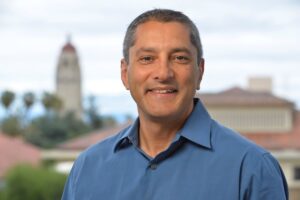 Juan G. Santiago, Ph.D.
Juan G. Santiago, Ph.D.
Vice Chair of Mechanical Engineering Department, Stanford
Friday, Dec. 9th at 3pm
Room 3550 MEK
Sid & Marian Green Classroom
ABSTRACT: Molecular diagnostics based on clustered regularly interspaced short palindromic repeats (CRISPR) enzyme systems have been the subject of intense research and rapid development in the last several years. CRISPR-associated (Cas) enzyme assays are easily reconfigurable to different nucleic acid targets and highly specific. Despite this potential, the limits of detection (LoDs) and possible applications of CRISPR-based diagnostics remain an open question. We discovered that the great majority of all CRISPR enzyme kinetics studies to date show data that grossly violate basic rules of mass conservation and rate laws. Following up on this finding, we quantified the kinetics of a wide range of CRISPR-Cas systems and established fundamental relations between reaction kinetics and LoD. We also recently demonstrated the specificity of CRISPR enzymes to small mutations, including SNPs.
CRISPR-based diagnostics are a good contender for point-of-care applications as they are operable at room temperature and compatible with lyophilized reagent. We report on our ongoing development of microfluidics devices for highly automated assays using isotachophoresis (ITP). ITP is an electrokinetic technique that can selectively and simultaneously purify, mix, and preconcentrate target species by more than 1,000 fold. We use this to accelerate CRISPR-Cas enzymatic reactions and focus post-reaction reporter molecules, including for SARS-CoV-2 detection.
BIO: Juan G. Santiago received his MS and PhD in Mechanical Engineering from the University of Illinois at Urbana-Champaign in 1995. He holds the Charles Lee Powell Foundation endowed professorship at Stanford and serves as Vice Chair of the Mechanical Engineering Department. His research includes the development of microsystems for on-chip biochemical analysis, microfluidic cell assay systems, two-phase flow devices, and capacitive deionization technologies. Applications of this work include molecular diagnostics, basic studies of cell biology, electronics cooling, and the production of drinking water. He is a Fellow of the American Physical Society, a Fellow of the American Society of Mechanical Engineering, and a Fellow of the American Institute for Medical and Biological Engineering. He was recently elected to the American Academy of Arts and Sciences. He serves as the Editor-in-Chief of the journal Flow. His work is cited about 1500 times per year (Google Scholar h index of 85). He has authored and co-authored over 200 archival publications and 250 conference papers, and he is a named inventor in 58 issued patents (25 of which are currently licensed).